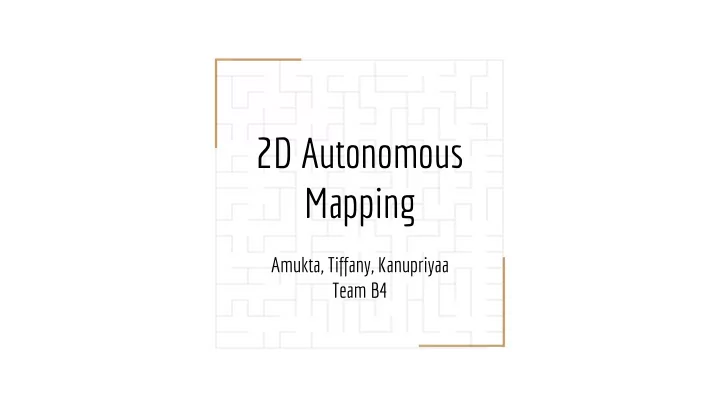

2D Autonomous Mapping Amukta, Tiffany, Kanupriyaa Team B4
Design Concept Need - Autonomous vehicles are often used to explore difficult to reach ● places (i.e. Search and Rescue, Scientific Exploration). Solution - This project aims to create a low cost, educational ● demonstration of autonomous mapping and navigation by building a vehicle that explores a simulated environment. Scope - Eliminate mechanical design challenges by reducing a real, ● textured environment to a static environment with smooth ground and flat walls. We will build a ground vehicle capable of producing a 2D map of the maze , traversing through it, and updating live changes to the maze ECE Areas : Software and Signals ●
System Specifications 1. Small wheeled vehicle capable of exploring an area with smooth surface. 2. Vehicle needs to traverse area above a minimum decided speed. 3. Must have a battery life of at least 2 hours. 4. Vehicle should keep track of map coverage (previously decided). 5. Software should be able to simultaneously do localization and mapping of the area. 6. Vehicle should travel efficiently without hitting any walls. 7. User must be able to start the vehicle from a webapp on a laptop. 8. User must be able to see the map being updated as vehicle moves.
Localization & Mapping Solution: We will build a software for our ground vehicle that simultaneously builds a map of the area and determines the robot’s (own) position within the map using the SLAM (Simultaneous Localization and Mapping) method. The combination of these components determines what the final algorithm would be: Mapping : Grid Maps ● Sensing : Single Point Lidar (RPLidar A1 ~$150) ● Sensor mode : Raw data aka 2D point cloud ● Kinetics : Previous commands given + odometry data ● Loop closure : Using kinetics data ● Not using : cameras, depth cameras, ranged lidar, topological maps, multiple object ● recognition, or landmark based mapping
Autonomous Mapping Solution: We will build a graphical representation of the map and implement a modified graph based search to verify map coverage. Store grid map coordinates of traversed “waypoints” as graph nodes ● Waypoints: approximate center point of each maze segment ○ Connect graph nodes using grid map data ● Record unexplored paths connected to known nodes ● Modified graph based search to determine order of exploring unknown paths ○ Check for 36 graph nodes to verify map coverage (6x6 grid maze) ● Loop closure algorithm checks if any of the nodes have already been explored by ● comparing current grid map with previous scanned data and avoids those nodes.
System Architecture Diagram
Electrical Schematic ● Lidar: RPLidar A1M8 (acquired) ○ 4 bytes per point (1 degree) ○ 1980 points / sec ○ Serial port baud rate 115200 ● Motor: 12V, 350 rpm DC motor + encoder ○ 229 ft / m ● Battery: Portable phone charger, 5V USB
Risk Assessment Risk Likelihood Mitigation Strategy Robot runs out of battery low Add an additional battery pack and make sure battery is fully during demo charged before a new run. Not enough processing power low Offload processing to laptop (IO delay, not autonomous), or on RPi to additional RPi Lidar burns out med Purchasing 2nd Lidar (anticipated in budget) Robot too slow med Reduce number of scans taken by LIDAR to increase speed (decreases accuracy of map). Low accuracy localization high Add camera feedback, tune SLAM configurations Robot stuck on walls / high Improve localization to path planning controls and tune distance to walls under configurations. Alternatively, add limit switch bumpers for RPLidar range additional sensing.
Performance Metrics Metric Measurement Indicator Target Vehicle Speed Encoder, # map segments explored > 20ft/min Map coverage Grid map completeness (pixels) > 95% of map explored Efficiency # dead ends, # unnecessary paths < 0, 2 maze segments revisited Efficiency Time to complete maze mapping < 5 mins Localization Estimated to actual position distance < 1 in accuracy Battery Life Time passed with robot operating 2 hours continuously
Validation Plan Maze Design: 1 ft wide hallways ● Modular 1x1x1 ft sections, combined to form ● different maze configurations Phase 1 Testing: Build small maze with 4-6 sections to test basic ● navigation (without autonomous mapping function) Phase 2 Testing: Expand maze to 6x6 grid demo size ● Test map coverage on various configurations ● Concurrently test map coverage algorithm ● with software simulations
Gantt Chart
Recommend
More recommend